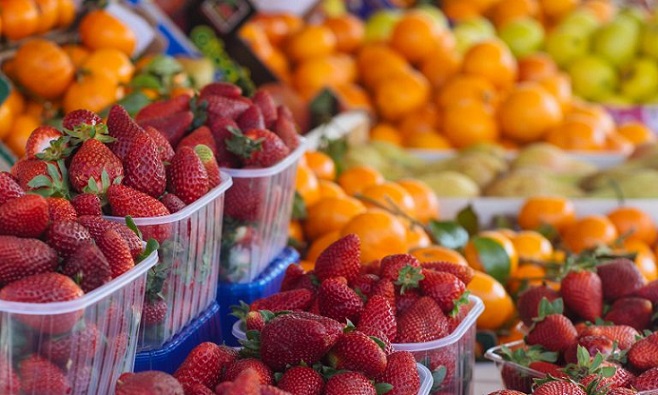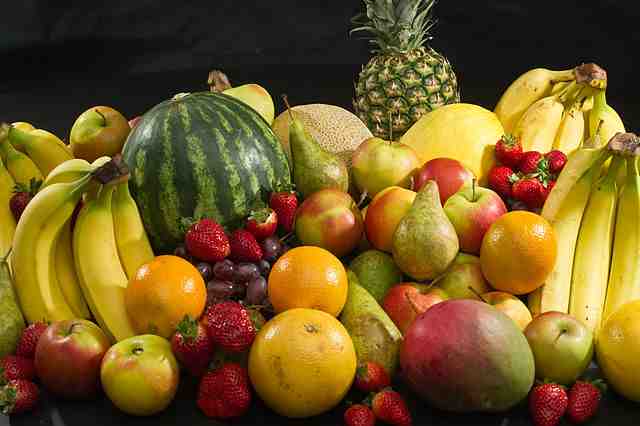Fruit
Their Value In The Diet
Fruit, as is generally understood, is the fleshy, juicy product of some plant or tree which, when ripe, is suitable for use as food. Although some fruits are seedless, they generally contain the seeds of the plants or trees that produce them. Many fruits require cooking to make them palatable, others are never cooked, and still others may be cooked or eaten raw, as desired. Fruits, because they are wholesome, appetizing, and attractive, occupy a valuable place in the diet. In fact, it is these qualities rather than their food value that accounts for the popularity of fruits among all people. In addition to causing fruits to appeal to the esthetic sense, their attractiveness serves another important purpose.
It is said that Nature made them attractive in color, odor, and flavor in order that birds might be allured to attack them for food and, by spreading the seeds, assist in their propagation. Fruits are gradually growing to be less seasonal and more a daily food, and are thus constantly becoming more prevalent in the diet. This condition may be attributed to the present rapid means of transportation and the excellent methods of cold storage that exist. Through these agencies it is possible to ship more or less perishable fruits long distances from their native localities and at times of the year other than the particular season in which they are at their best in the places where they are grown.
Thus, fruits that were formerly considered a luxury may now be served regularly, even on the tables of persons having only moderate means. The fact that fruits are being more extensively used every day is as it should be, for this food is entitled to an important place in the diet of all persons. So important is fruit in the diet that it must be looked on not as one of the things that may be taken or omitted as a person wishes without making any difference either way, but as a food to include in one form or another in nearly every meal. The child who is so young that it cannot take any solid food may have fruit juices included in its diet to decided advantage; but children who are slightly older and adults may take the fruits cooked or raw instead of in the form of juices. As far as the composition of fruits is concerned, it is such that most fresh fruits are not particularly high in food value.
However, they are characterized by other qualities that make up for what they lack in this respect; then, too, what they contain in the way of heat-producing or tissue-building material is easily digestible. Most fruits contain considerable acid, and this food substance makes them stimulating to the appetite. Advantage of this fact is taken when fruits are served at the beginning of a breakfast or when several of them are combined in a fruit cocktail and served before luncheon or dinner. This acid produces real stimulation in the stomach, resulting in a flow of gastric juice from the glands of the stomach walls. In addition, the delightful color, the fragrant odor, or the pleasant taste of fruit, although a mental effect, is just as real and just as valuable as the actual stimulation of the acids.
Many fruits are eaten raw, while others are cooked either because they require cooking to make them appetizing or because it is desired not to use them in their raw state. The cooking of fruits has a variety of effects on them, being sometimes advantageous and other times detrimental. The flavor is always changed by the application of heat, and in some cases the acid that fruit contains becomes stronger. On the other hand, the fibrous material, or cellulose, of fruits is softened by cooking and thus becomes more digestible. Then, too, the sugar that is usually added to fruits in their cooking increases their food value.
Because of these facts, cooked fruits have considerable value and, like raw fruits, should have an important place in the diet. Those fruits which are dried and usually eaten raw, such as figs and dates, supply much nourishment in an easily digestible form. The medicinal value of fruit has long been considered to be of importance, but this may be almost entirely disregarded, for, with the exception of the fact that most fruits are valuable as a laxative, there is nothing to consider. However, several fruits, such as blackberries and bananas, have an anti-laxative effect, and large quantities of these should for the most part be avoided, especially in the feeding of children. In general, fruits are divided into two classes, namely, food fruits and flavor fruits. As their names imply, food fruits are valuable as food, whereas flavor fruits are those distinguished by a characteristic flavor.
It should be remembered that the flavors, as well as the odors, of fruits, are due chiefly to what is known as their volatile, or ethereal, oils. Fruits in which these oils are very strong are often irritating to certain persons and cause distress of some sort after eating. The purpose here is to acquaint you with the relative value and uses of the various kinds of fruit, to teach you the best methods of preparation, and to supply you with recipes that will encourage you to make greater use of this valuable food in your family's diet. While it is hardly possible to use fruits too extensively, they must not be allowed to take the place of other more nourishing foods that are required by the body. Therefore, in order to make proper use of them, their value in the diet should not be overlooked.
Nature Of Fruits And Advances In Cultivation
Vegetables With Added Nutritional Value
InternetBusinessIdeas-Viralmarketing Home Page
Tweet
Follow @Charlesfrize












New! Comments
Have your say about what you just read! Leave a comment in the box below.